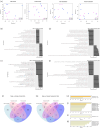Maternal high fat and high sugar diet impacts on key DNA methylation enzymes in offspring brain in a sex-specific manner
- PMID: 40373797
- PMCID: PMC7617894
- DOI: 10.1111/jne.70046
Maternal high fat and high sugar diet impacts on key DNA methylation enzymes in offspring brain in a sex-specific manner
Abstract
Maternal obesity associates with an increased risk of offspring neurodevelopmental disorders. Although the underlying mechanism(s) remain unclear, evidence suggests a role for altered DNA methylation. We utilized a murine model of diet-induced obesity to investigate the impact of maternal obesity on the offspring brain transcriptome and DNA methylation. C57Bl/6 dams were fed high-fat high-sugar (HFD, n = 7) or control (CON, n = 7) diets. Maternal obesity/hyperglycemia associated with offspring growth restriction, with brain-sparing specifically in females. Postnatal hypoglycemia was seen in HFD males, but not females. The 3' RNA-sequencing revealed perturbations in metabolic and cell differentiation pathways in neonatal male and female offspring frontal cortex and cerebellum. Compared with controls, HFD males, but not females, had lower cortical and cerebellar DNMT gene and protein expression, and reduced cerebellar TET enzyme mRNA. Whilst female offspring had lower cerebellar 5-methylcytosine (5mC) and 5-hydroxymethylcytosine (5hmC) than males, there were no effects of HFD on 5mC/5hmC in cortex or cerebellum in either sex. Our data suggest that maternal obesity has sex-specific effects on fetal neurodevelopment, including enzymes involved in DNA methylation/demethylation. These mechanisms may play a role in the increased risk of neurodevelopmental disorders following obese/diabetic pregnancies, including increased male susceptibility to these disorders.
Keywords: DNA methylation; epigenetics; neurodevelopment; obesity; pregnancy.
© 2025 The Author(s). Journal of Neuroendocrinology published by John Wiley & Sons Ltd on behalf of British Society for Neuroendocrinology.
Conflict of interest statement
The authors declare no conflicts of interest.
Figures




References
-
- Ng M, Fleming T, Robinson M, et al. Global, regional, and national prevalence of overweight and obesity in children and adults during 1980–2013: a systematic analysis for the global burden of disease study 2013. The Lancet. 2014;384(9945):766‐781. doi: 10.1016/S0140-6736(14)60460-8 - DOI - PMC - PubMed
MeSH terms
Substances
Grants and funding
LinkOut - more resources
Full Text Sources

